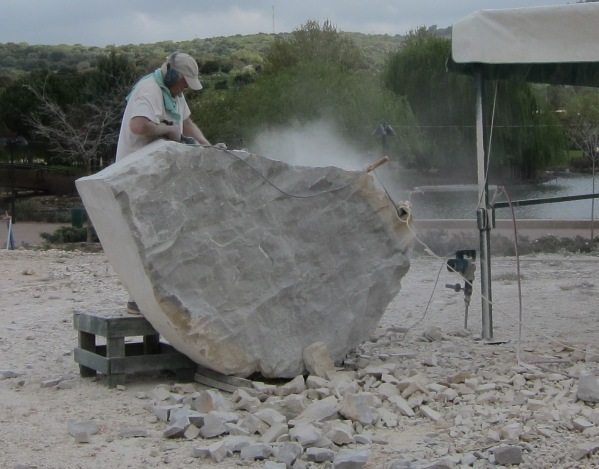
Maalot-Tarshiha occupies a unique place in the Israeli urban landscape, with roughly 250 sculptures displayed throughout the city, the legacy of the sculpture symposium “Stone in the Galilee.” Now in its 21st year, Stone in the Galilee will take place from April 20 – 24, 2011, with music, theatre, story-time for children and workshops throughout the days of the festival from noon to night. Opening night events on Wednesday, April 20, 2011, will include a performance by Knesiat Hasechel (The Church of Reason) and the ethnic rock band Druze.
11 artists were selected from a short-list of 35 finalists to spend three weeks in Maalot-Tarshiha, creating the stone sculptures that will be completed during the festival. The theme for this year is “stone in motion” and each artist has developed his or her own interpretation and response. This year’s cohort of sculptors includes: Ebru Akinci from Turkey, Aleksandre Phophkhadze from Georgia, Shigeru Hayashida from Japan, Maftei Ion from Romania, Li Chao from China, Mikhail Levchenko from the Ukraine, Kamen Tanev from Bulgaria and Roy Givati, Jamal Hassan, Igal Miron, and Yoram Afek from Israel. On a recent visit to Maalot-Tarshiha, I took a walk through their outdoor work area by Lake Monfort and chatted with the artists.
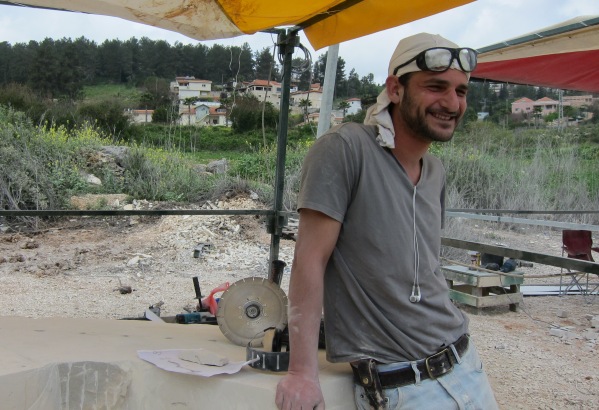
Israeli Roy Givati has lived in Italy for the past 10 years, first studying painting in Florence, and then studying restoration in the mornings and sculpture in the evenings in Carrera where he lives and works today. Although he was drawn to the hills of Carrera, to live amid the stone, Roy would like to return to Israel. Recreating in stone the resilience and flow of movement of fabric in the wind, he showed me the sketch for his sculpture.


Jamal Hassan, painter, sculptor and art teacher at Atid College in Yarka (Druze village northeast of Acco) is working on a sculpture called “Waltz Dance” an abstraction of two figures, dancing. “The sound of stone in the ear is associated with something static, heavy, rough,” said Hassan, “I am trying to create a situation of movement. I think one must find a dialogue between the sculptor, stone and implement. Not to attack the stone but to flow with it.”
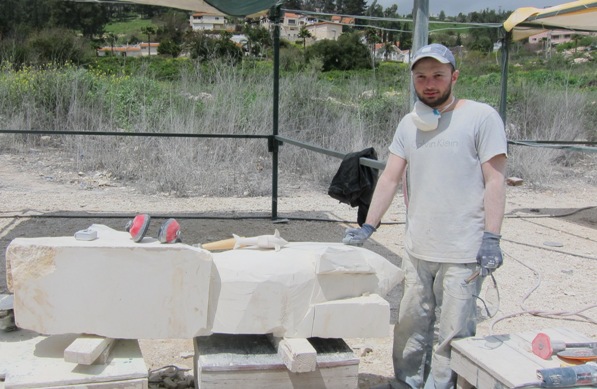
“It is very beautiful here,” said Aleksandre Phophkhadze from Georgia. His teacher participated in last year’s symposium and told him about it. Phophkhadze usually sculpts in different materials, stone, wood and metal. He is currently working on a sculpture of three dolphins.
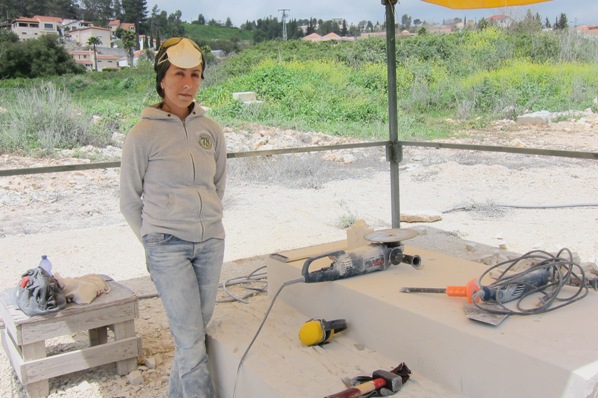

Ebru Akinci from Istanbul, is working on a sculpture titled: River. She usually works with stone, sometimes with wood or bronze. This is Akinci’s first visit to Israel and she says that so far, “I see that our cultures are very similar to each other.”
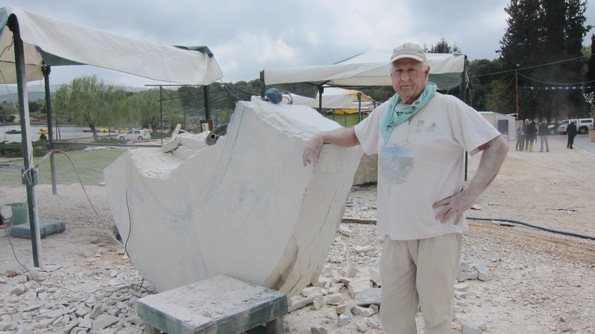
Igal Miron from Kibbutz Ayelet Hashahar is participating in the symposium for the third time; he was a judge in the first Stone in the Galilee symposium in 1992. “I am raising an issue for discussion,” said Igal, “sculpture always sways between very refined designs and those that are wild and free… sometimes you can’t even tell that a sculpture is made of stone. I like to let the stone speak.” The design for his sculpture “Swing” is a half circle, one side will be very smooth and the other wild and rough, with a stone balancing at one end of the semi-circle. Looking at the model, I asked if the finished work will actually swing. “If it will be possible,” said Miron, explaining that due to the large dimensions of the sculpture, it is not clear if it will be able to be free to move for safety reasons. However, Miron is making a few smaller works relating to the theme that will be mobile. “From the moment I was born I remember being involved in this – painting, sculpting, it’s part of me, part of what I do,” said Miron, “An artist is someone who can’t live without creating art. With me, it’s usually the idea that defines the material. I want to make sure that the idea receives the expression that suits it best.” Therefore, Miron works with a wide range of materials and techniques.
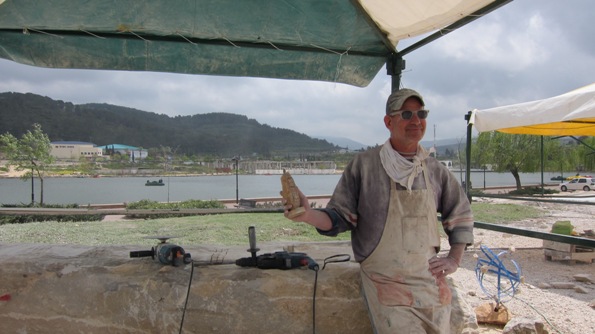
Yoram Afek’s “Ladder” will go up one side and down the other with colorful inlay. Afek usually works in iron and likes to combine different materials in a single sculpture. Teaching at the Kibbutz Seminar in Tel Aviv and Beit Berl, Afek said he is enjoying the experience “To have two weeks to myself to create.” He notes that “the art world can be very aggressive, competitive, with egos clashing, here, artists from all over the world meet and work side by side.”

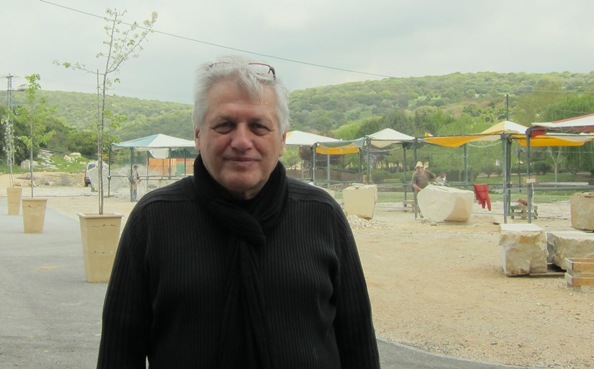
Sculptor Moshe Perelman initiated the symposium in 1992. “I had participated in such symposiums in France and Italy,” said Perelman, “and I wondered why we don’t have something like this in Israel.” He brought the idea to Shlomo Buhbut, Mayor of Maalot-Tarshiha, and recalls, “I showed him pictures, he got the budget for it, and we had our first symposium.” Yet the early days were not without their problems. “It’s hard to introduce art to the public,” said Perelman, “we’d come in the morning and find sculptures with pieces broken off – now the kids are the best guardians of the sculpture. We made art education happen through this symposium.”

Noga Migdal, Curator of this year’s symposium and Director of the Apter Barrer Art Center, said that there are plans to create a sculpture part around Lake Monfort to provide a better display for the many sculptures in the city. In tandem with the symposium, there will be an exhibit of 15 Israeli sculptors at the Apter-Barrer Center, which will open on April 20, 2011 at 20:00. There will also be art workshops at the Center during the days of the festival, in addition to the festivities taking place on the Lake.
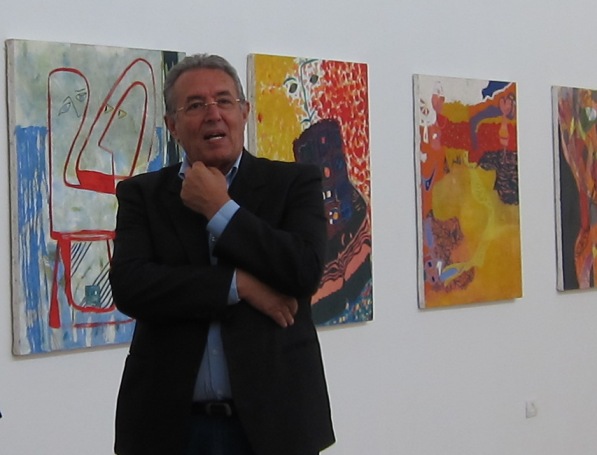
Shlomo Buhbut, Mayor of Maalot-Tarshiha, is justly proud of the city’s accomplishments, in addition to the annual sculpture symposium the city is very involved in sports, with ice hockey, an international fencing tournament, and an international mountain-biking competition, as well as DocAviv Galil, a festival of documentary films, initiated two years ago as a northern offshoot of DocAviv.
Keep up to date with the sculptor’s progress on Maalot-Tarshiha’s website. For more information, call: 04-9578871/68.






[…] further reading please visit the wonderful blog post of Midnight East: http://www.midnighteast.com/mag/?p=11730 Share this:TwitterFacebookLike this:LikeBe the first to like this post. ▶ No Responses /* […]
We live in Ma’alot and appreciate this blogpost as I was able to share it with my friends!
Comments are closed.